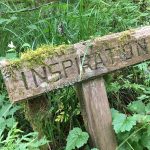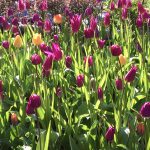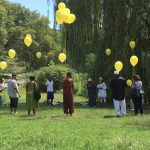Getting Back Out: A City Dweller’s COVID Reflection on Nature in Place
March 31, 2021
By Pamela Berns

In the lushness and vastness of the Western wilderness, the city dweller’s daily fight for blades of grass, open skies, and majestic mountains feels more like a calling than a battle. The city, with its tall buildings slicing the sky into slivers, darkening the streets long before sunset, can overwhelm with cynicism. Energy efficiency, walkable streets, LEED Platinum skyscrapers. The goal is clear, to save our planet. But out there in hopeful hills and valleys, where billions of stars blanket the night sky, you can actually see what it is you are saving.
Getting Back Out: A City Dweller’s Covid Reflection on Nature in Place
My hike had been tough that first day out in the Oregon Cascades. Something had gone not quite right with me. In the twelve years of these journeys to the West I’d always hiked right upfront, just behind the leader. This time I found myself bringing up the rear, an involuntary “sweep,” barely able to keep up with John, a fellow hiker with a hip replacement, who was 15 years my senior. I could attribute my sluggishness to altitude, or just blame the city for taking it all out of me. Time will heal, I told myself. If not today, then tomorrow.
It was the last trip I took before the pandemic descended upon the world and closed mine.
Hiking was the logical extension of my New York City walks, which served for many years as my primary transportation in place of subway rides. Long before everyone started walking to work in Nikes after the 1980 transit strike, I commuted via the paths of Central Park. I kept a collection of high heeled shoes (different colors to match different outfits) in my bottom file drawer, which I slipped on for meetings with my bosses and clients. In retrospect, I could pride myself for putting my feet to work for the sake of the environment, but the truth is subways always gave me claustrophobia—too many memories of being stuck between stations, my heart pounding faster and faster with a terrified certainty that I’d never emerge and never again see the light of day.
It was during my trips out West that I learned who I really was and why I dreaded the trains and deeply desired the trails. Trails move and transform, carrying you along to surprise after surprise, ponds reflecting clouds, streams and waterfalls trickling and spraying, and scents you want to bottle. Darkness, when it does come, seems only temporary as trees obscure the sunlight, creating dappled shadows on the ground. Then you come to the next clearing, or ascend to a peak, where the expanse extends many miles out and 360 degrees around.
In the lushness and vastness of the Western wilderness, the city dweller’s daily fight for blades of grass, open skies, and majestic mountains feels more like a calling than a battle. The city, with its tall buildings slicing the sky into slivers, darkening the streets long before sunset, can overwhelm with cynicism. Energy efficiency, walkable streets, LEED Platinum skyscrapers. The goal is clear, to save our planet. But out there in hopeful hills and valleys, where billions of stars blanket the night sky, you can actually see what it is you are saving.
It’s been over a year of life under COVID. Lockdowns have ebbed and flowed, alongside surges of infections that enveloped the nation. “Stay at home,” wrote essayist and naturalist John Burroughs around the turn of the twentieth century, as though dispensing the lifesaving advice of a present-day medical expert. “See the wonderful and the beautiful in the simple things all about you; make the most of the common and the near at hand.”
I listened, I acquiesced. I wore my mask and stayed close to home.
But I belonged outside, in the open—I was meant to move, not to sit. So I walked in Central Park nearly every day once the world moved inward, regardless of weather. I meandered through hilly, wood chip covered trails in the Park’s North Woods. I climbed the schist outcroppings, around which the park was constructed, a testimony to the natural world’s refusal to fully give way to the architects’ vision of this urban oasis inspired by the Adirondacks. If I pretended I didn’t know its waterfalls could all be halted with the turn of a spigot, these panaceas could quell my longing.

I meandered among crocuses and cherry blossoms in the most magnificent spring New York could remember, with construction projects halted and commuters all but gone from the buses and taxis. Pollution disappeared like magic, and the cricket’s song replaced the whir of passing cars during the evening rush hour. Amazingly, the City became my respite. I followed the turning of seasons in the Park, as spring green leaves grew larger and turned a darker shade of kelly, then yellow and red, as the birds in this great flyway migrated back to their southern homes. Soon the wind picked up and fallen leaves swirled about, foretelling the cold winter to come. How lucky was I to have been in this never before, never again time and place?
“Why should I go gadding about to see the strange and the extraordinary?” Burroughs wrote. If the pandemic taught me nothing else, it was that, like Dorothy of Oz and Van Gogh in the Saint-Rémy-de-Provence asylum, I learned to find beauty and awe just outside my own window. I looked out on my New York City block at four story rust colored Victorians and, with a squint, could see the hoodoos of Utah’s National Parks. Young trees seemed to aspire to redwood grandeur, and miniature flower beds, if they could all be patched together, might make a glorious quilt of expansive meadows.
Now our indefatigable City is reasserting itself: restaurants, performance venues, even Madison Square Garden, are gradually, if cautiously, reawakening a different, more familiar energy. Subway turnstiles no longer sit idle. Construction projects have resumed with a determination to make up for lost time, filling the briefly idyllic streets with cacophony and the air with dust and grit. But the City we once knew has changed, we’ve all changed—those of us who stuck around learned not just to persevere in a whole new way, but also to appreciate on a profound new level.

As for me, with the miracle of a vaccine, I’ll be flying again soon, like the red tailed hawks who became my constant companions in my urban forays. With the circuitous paths and the miniature mountains of Central Park as my training grounds, I will continue to get in shape for my next trip West. Maybe, though, I have adjusted my sights; just being there again will be enough—even if I find myself lagging behind.
Excerpted and adapted by the author from a collection of essays.
©2021 Pamela E. Berns All Rights Reserved
Interested in learning more about the effects of COVID-19 on our everyday world? Check out our upcoming April Monthly Forum event, which will feature a focus on COVID-19 energy consumption.
